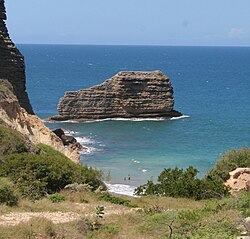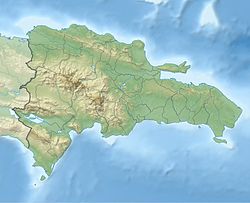San Fernando de Monte Cristi, usually just Monte Cristi, is a city in the Dominican Republic and the head municipality of the Monte Cristi province, in the northwest of the nation.
Monte Cristi | |
|---|---|
Municipality | |
| San Fernando de Monte Cristi | |
 El Zapato ("Small shoe"), El Morro, Monte Cristi | |
| Coordinates: 19°51′0″N 71°39′0″W / 19.85000°N 71.65000°W | |
| Country | Dominican Republic |
| Province | Monte Cristi |
| Founded | 1533 |
| Municipality since | 1822 |
| Area | |
| • Total | 517.4 km2 (199.8 sq mi) |
| • Urban | 11.40 km2 (4.40 sq mi) |
| Elevation | 16 m (52 ft) |
| Population (2014)[1] | |
| • Total | 24,644 |
| • Density | 48/km2 (120/sq mi) |
| • Urban | 15,141 |
| Demonym(s) | Montecristeño (female, montecristeña) |
| Time zone | UTC-4 (AST) |
| • Summer (DST) | UTC-4 (AST) |
| Distance | 115 km (71 mi) to Santiago 270 km (170 mi) to Santo Domingo |
Name
changeThe name comes from the name given by Columbus on 4 January 1493 to the mountain known now as El Morro: Monte Cristo or Monte Christi ("Mountain of Christ").[4]
The name of the city has been written of different ways: Monte Cristi (Columbus), Monte Cristo (Ferdinand Columbus), Monte Christi or Monte Christo (Las Casas), Monte Cristy and Montecristi. But the name most used is Monte Cristi.[5]
When the city was founded again in 1751, the name was changed to the present one, San Fernando de Monte Cristi, after Ferdinand VI, King of Spain.
Population
changeThe municipality had, in 2014, a total population of 24,644: 12,892 men and 11,752 women. The urban population was 61.4% of the total population.[1]
History
changeThe city was founded by Juan de Bolaños in 1533;[6] but Rodríguez says that it was in 1545 by Francisco Mesa.[5] Some families from the Canary Islands came to live here. Because it was too dry and hot, there was not possibility of any kind of farming, except some cattle raising, and the city was developed as a port.
The town was destroyed in 1606 by order of the Spanish government and the inhabitants were moved, together with the inhabitants of Puerto Plata inhabitants, away from the northern coast to form the new town of Monte Plata. In 1751, Monte Cristi was founded again by order of the king Ferdinand VI of Spain.[7]
Geography
changeMonte Cristi is in the northwestern end of the Cibao Valley, near the Montecristi Bay. The city is just to the north of the mouth of the River Yaque del Norte.
To the north of the city is the western end of the Cordillera Septentrional ("Northern mountain range"); the last mountain of this range is El Morro.
The municipality has a total area of 517.4 km2 (199.8 sq mi) 535.87.[1] The region around the city is very dry and hot.
The altitude of the city of Monte Cristi is 16 m (52 ft) above sea level.[3]
Climate
changeMonte Cristi has a tropical savanna climate (Köppen-Geiger classification: As) with a pronounced dry season on summer, and an wet season on winter.[8]
The average amount of rainfall for the year in the city is 672.1 mm (26.5 in). The month with the most precipitation on average is November with 108.2 mm (4.3 in) of rainfall, followed by December with 84.1 mm (3.3 in).
The driest season is summer. The month with the least rainfall on average is July with an average of 21.5 mm (0.8 in) followed by August, 28.1 mm (1.1 in).
Monte Cristi is in a warm region; the average temperature for the year is 26.5 °C (80 °F). The warmest month, on average, is August with an average temperature of 28.5 °C (83.3 °F). The coolest month on average is January, with an average temperature of 24.1 °C (75.38 °F).
| Month | Jan | Feb | Mar | Apr | May | Jun | Jul | Aug | Sep | Oct | Nov | Dec | Year |
|---|---|---|---|---|---|---|---|---|---|---|---|---|---|
| Average high °C (°F) | 28.9 (84.0) |
29.4 (84.9) |
30.2 (86.4) |
30.5 (86.9) |
31.8 (89.2) |
33.3 (91.9) |
33.6 (92.5) |
33.8 (92.8) |
33.7 (92.7) |
32.7 (90.9) |
30.7 (87.3) |
29.2 (84.6) |
31.5 (88.7) |
| Daily mean °C (°F) | 24.1 (75.4) |
24.5 (76.1) |
25.1 (77.2) |
25.8 (78.4) |
27.0 (80.6) |
28.2 (82.8) |
28.4 (83.1) |
28.5 (83.3) |
28.3 (82.9) |
27.5 (81.5) |
25.9 (78.6) |
24.5 (76.1) |
26.5 (79.7) |
| Average low °C (°F) | 19.2 (66.6) |
19.6 (67.3) |
20.1 (68.2) |
21.1 (70.0) |
22.2 (72.0) |
23.0 (73.4) |
23.2 (73.8) |
23.3 (73.9) |
22.9 (73.2) |
22.4 (72.3) |
21.3 (70.3) |
19.8 (67.6) |
21.5 (70.7) |
| Average rainfall mm (inches) | 73.8 (2.91) |
47.3 (1.86) |
47.7 (1.88) |
59.0 (2.32) |
59.8 (2.35) |
40.1 (1.58) |
21.5 (0.85) |
28.1 (1.11) |
34.8 (1.37) |
67.7 (2.67) |
108.2 (4.26) |
84.1 (3.31) |
672.1 (26.47) |
| Source 1: NOAA[9] | |||||||||||||
| Source 2: Climatemps.com[8] | |||||||||||||
Economy
changeThe most important economic activities in the municipality are fishing and salt production. Farming is important near the River Yaque del Norte, and the main crops are bananas and rice.
Tourism is also important here, with the different beaches near the city and people that come here for fishing.
References
change- ↑ 1.0 1.1 1.2 1.3 Consejo Nacional de Población y Familia. "Estamaciones y Proyecciones de la Población Dominicana por Regiones, Provincias, Municipios y Distritos Municipales, 2014" (PDF) (in Spanish). Retrieved 2014-02-02.
- ↑ "Expansión Urbana de las ciudades capitales de R.D. 1988-2010. Informe Básico" (PDF) (in Spanish). Oficina Nacional de Estadística. April 2015. p. 52. Retrieved 10 December 2016.[permanent dead link]
- ↑ 3.0 3.1 De la Fuente, Santiago (1976). Geografía Dominicana (in Spanish). Santo Domingo, Dominican Republic: Editora Colegial Quisqueyana.
- ↑ Columbus, Christopher; de las Casas, Bartolomé, Dunn, O.C., and Kelley, James E. (1989). The Diario of Christopher Columbus's First Voyage to America, 1492-1493. Norman: University of Oklahoma Press. ISBN 9780806121017.
{{cite book}}: CS1 maint: multiple names: authors list (link) - ↑ 5.0 5.1 Rodriguez Demorizi, Emilio (1972). Relaciones Geográficas de Santo Domingo, vol. I. Santo Domingo, Dominican Republic: Sociedad Dominicana de Geografía. pp. 284–285.
- ↑ Pouerié Cordero, M.M. (1997). Síntesis de ciudades, pueblos e islas del país (in Spanish). Santo Domingo, Dominican Republic: Impresora Mary.
- ↑ "División Territorial 2015" (in Spanish). Oficina Nacional de Estadística (ONE). October 2015. Archived from the original (PDF) on 14 November 2015. Retrieved 16 November 2016.
- ↑ 8.0 8.1 "Monte Cristi Climate & Temperature". Climatemps.com. Retrieved 16 November 2016.
- ↑ "Monte Cristi Climate Normals 1961-1990". National Oceanic and Atmospheric Administration. Retrieved 16 November 2016.
| Provincial capitals of the Dominican Republic | |
|---|---|
| Azua • Baní • Barahona • Bonao • Comendador • Cotuí • Dajabón • El Seibo • Hato Mayor • Higüey • Jimaní • La Romana • La Vega • Mao • Moca • Monte Cristi • Monte Plata • Nagua • Neiba • Pedernales • Puerto Plata • Sabaneta • Salcedo • Samaná • San Cristóbal • San Francisco de Macorís • San José de Ocoa • San Juan de la Maguana • San Pedro de Macorís • Santiago de los Caballeros • Santo Domingo • Santo Domingo Este | |

